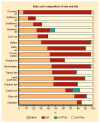Dietary monounsaturated fatty acids appear not to provide cardioprotection
- PMID: 20725810
- PMCID: PMC2995267
- DOI: 10.1007/s11883-010-0133-4
Dietary monounsaturated fatty acids appear not to provide cardioprotection
Abstract
Dietary interventions have been consistently proposed as a part of a comprehensive strategy to lower the incidence and severity of coronary heart disease (CHD), in the process providing long-term cardioprotection. Replacement of dietary saturated fatty acids (SFA) with higher intakes of monounsaturated fatty acids (MUFA) and polyunsaturated fatty acids (PUFA) has been reported to be inversely associated with risk of CHD. The observed lower incidence of CHD among populations consuming a Mediterranean-type diet, mainly enriched in MUFA from olive oil, has long supported the belief that MUFA are an optimal substitution for SFA. However, both epidemiologic and interventional studies suggest that although substituting MUFA-rich foods for SFA-rich foods in the diet can potentially lower total plasma cholesterol concentrations, this substitution does not lower the extent of coronary artery atherosclerosis. In addition, although recent evidence suggests that the source of MUFA (animal fat vs vegetable oils) may differentially influence the correlation between MUFA intake and CHD mortality, animal studies suggest that neither source is cardioprotective.
Conflict of interest statement
Figures
References
-
- Mente A, de Koning L, Shannon HS, Anand SS. A systematic review of the evidence supporting a causal link between dietary factors and coronary heart disease. Arch Intern Med. 2009;169:659–669. - PubMed
-
- Keys A. Coronary heart disease in seven countries. Circulation. 1970;41(Suppl1):1–211. - PubMed
-
- de Lorgeril M, Salen P. The Mediterranean diet: rationale and evidence for its benefits. Curr Atheroscl Rep. 2008;10:518–522. - PubMed
-
- Keys A, Anderson JT, Grande F. Prediction of serum-cholesterol responses of man to changes in fats in the diets. Lancet. 1957;2:960–966. - PubMed
-
- Hegsted DM, McGandy RB, Myers ML, Stare FJ. Quantitative effects of dietary fat on serum cholesterol in man. Am J Clin Nutr. 1965;17:281–295. - PubMed
Publication types
MeSH terms
Substances
Grants and funding
LinkOut - more resources
Full Text Sources
Other Literature Sources


